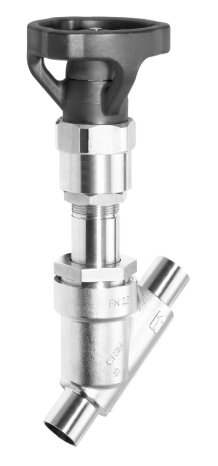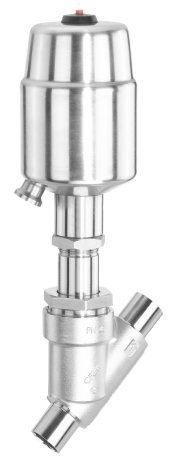In the foodstuff industry, the chemical and pharmaceutical industry, and even in other industrial sectors, products must sometimes be manufactured aseptically. As a result, stringent requirements are made of the purity of the working media which are used during manufacture and even the quality of the steam used. If steam comes into contact with surfaces or directly with liquid or gaseous products during aseptic production, this contact must satisfy the purity requirements of these products. The solution is found in complex pure steam systems at product requirement level. GEMÜ has long maintained intensive contacts with plant engineers and operators who have these systems in use and took one particular customer project as a suitable occasion for checking its valve solutions and developing them further.
Aseptic globe valve scores highly on performance and maintenance
In a close exchange of ideas with a well-known customer from the pharmaceutical industry, the GEMÜ 505 and GEMÜ 555 angle seat globe valves were created for pure steam shut-off valves, as described below. The pneumatic (GEMÜ 555) and hand-operated (GEMÜ 505) angle seat globe valves have been specially developed for this application and provide a genuine alternative to the valve types which have usually been employed until now. For example, they require significantly less maintenance than diaphragm valves, are easier to handle than ball valves and are more deadleg optimized than butterfly valves. These globe valves are available in the nominal sizes DN8 - DN80 and due to their metal bellows and selected seals they can be used at medium temperatures of -10 to +180 ºC. The butt weld spigot connections are available in common standards (ASME BPE, DIN 11866, DIN EN ISO 1127).
High quality - High value for money
When designing the new globe valve range, it was important to meet the high quality and safety requirements demanded of the pure steam processes without losing sight of the question of the purchasing cost. For reasons of quality, all wetted parts are made of high quality stainless steel (316L), while internally the valve body is actually mechanically machined clean and externally electropolished. As far as surface quality is concerned, we are able, thanks to the body geometry on the inside of the body, not only to produce Ra values of down to 0.4 µm but to even reproduce them. In addition, particular importance was also attached to the seal materials (seat code 5P) which also satisfy the stringent requirements of the FDA. The seals were tested according to USP Class VI at 121°.
Even in the actuators, the basic materials and the processing of the individual materials are impressive, whether it is the stainless steel bellows which accomplishes up to 100,000 cycle duties without problems and enables the actuator to use non-ferrous metals. Or whether it is the valve plug which is designed without threads and, as a result, requires little maintenance and which is provided with a seal made of extremely inert, acid and heat-resistant thermoplastic synthetic material (PTFE). Or it may be the special feature that the valve plug is sealed with the valve spindle and then smoothed and, as a result, eliminates the otherwise usual "dirt pockets" which occur with valve plug solutions which are bolted together. Because of these and other finer points, both angle seat globe valve variants provide a long service life including outstanding material properties and body geometries.
Traceability is assured
As early as the creation stage of the user specification, particular requirements were defined for the production process and the maintenance of these angle seat globe valves. In particular, this included the creation of a traceability chain for all wetted parts. For this reason, valve bodies, retaining nut, seat, valve plug, spindle, bellows and actuator seal of the GEMÜ 555 and GEMÜ 505 are manufactured in specific batches and combined together in one production run. As a result, material test certificates in accordance with 3.1 DIN EN 10204 can be issued and supplied with the product if required. In addition to the design of the valve as a low maintenance fitting in terms of material, it was also ensured that an actuator change can be carried out quickly, directly on the piping. This means it is possible to perform cost-effective maintenance and repair work and protects materials over the long term. If desired by the customer, the valve solution can also be subsequently automated, for example by switching from manual to pneumatic operation or by later attaching electrical position indicators or positioners.


